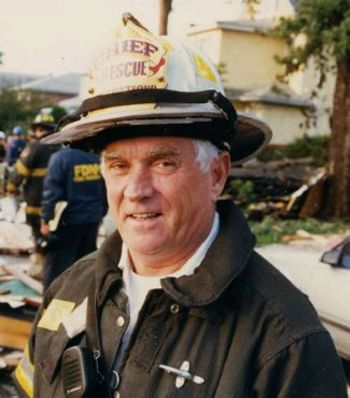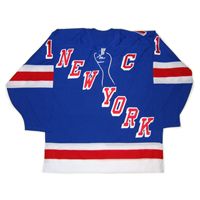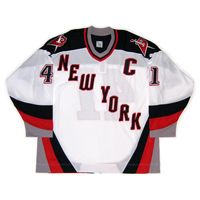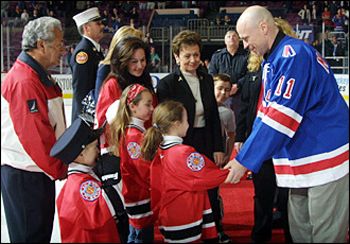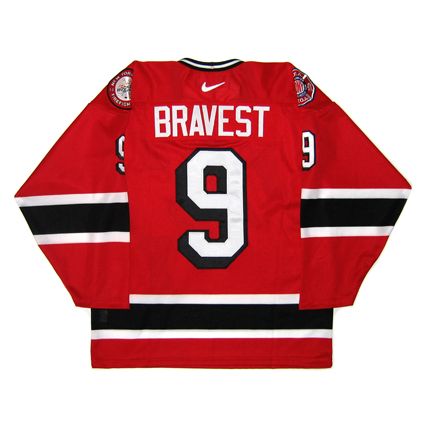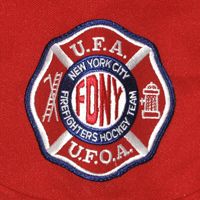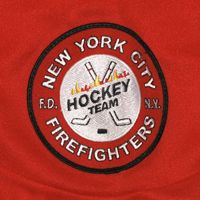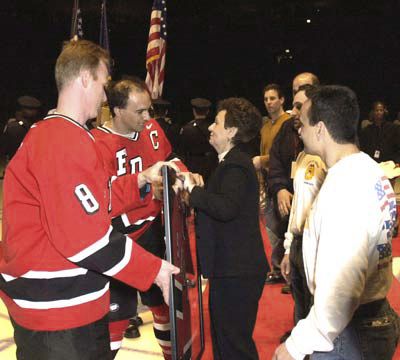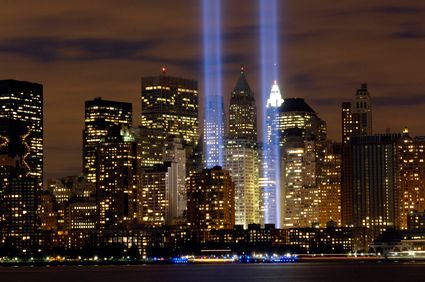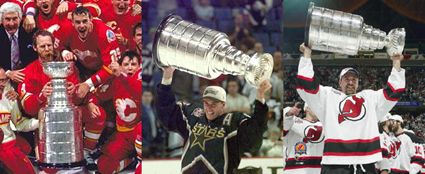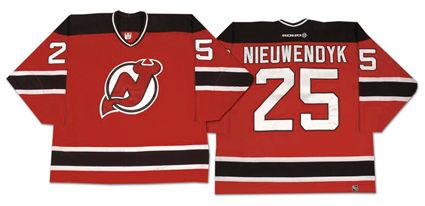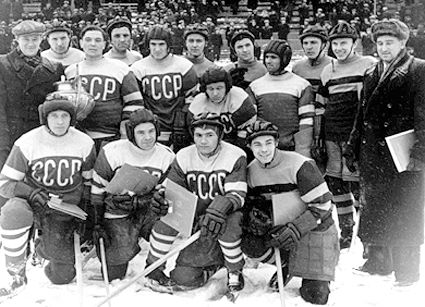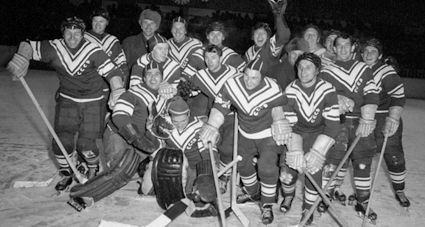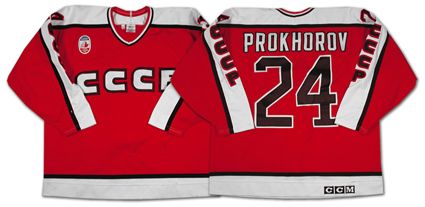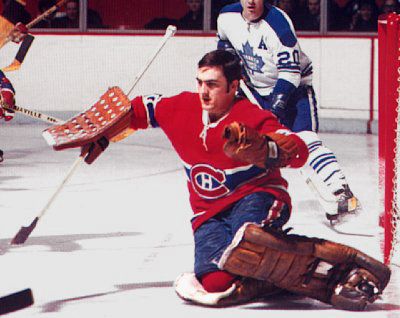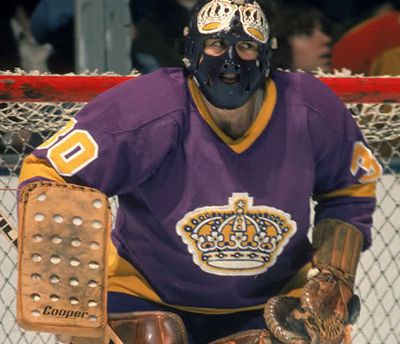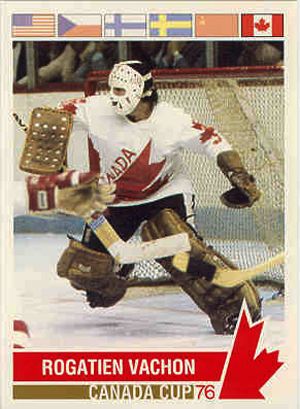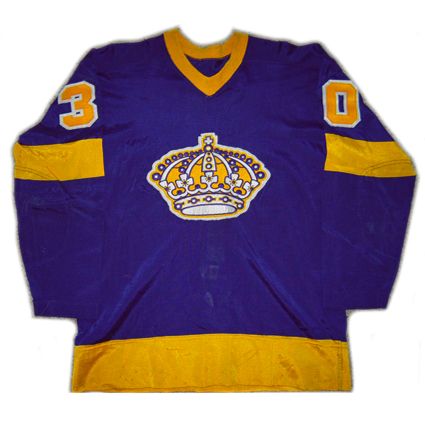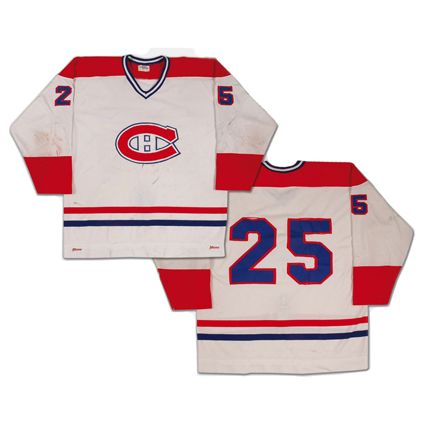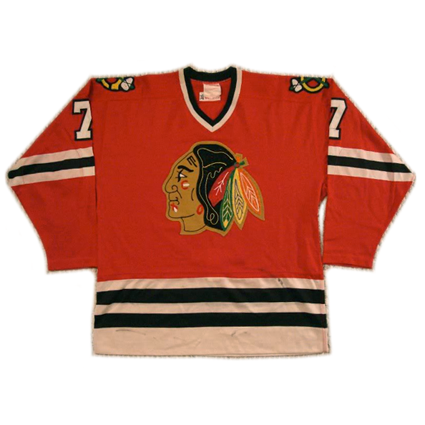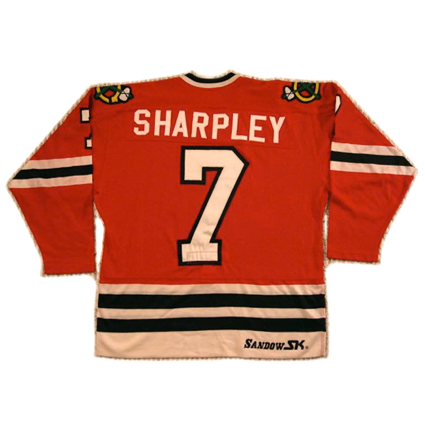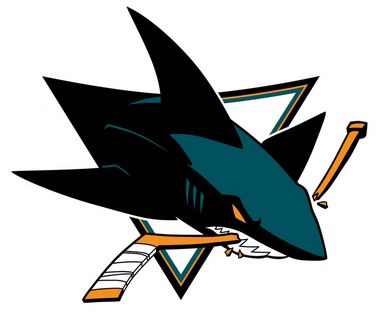Saturday, September 11, 2010
2000-01 FDNY Hockey Team Ray Downey Jersey
Ray Downey was the Fire Department of New York's Chief of Special Operations and a passionate New York Rangers fan and founding member of the FDNY Hockey Team.
He served with the United States Marine Corps and then became a member of the Fire Department of New York (FDNY) on April 7, 1962, beginning a 39-year career. In August of 2001, Chief Downey was put in charge of Special Operations Command, a team of specialists who aid regular firefighters with unique or highly critical situations, which include Hazardous Materials, Marine Units, Rescue Companies (experienced units with specialized tools and equipment) and Squads, often regarded as mini Rescue Companies who also have specialized tools and equipment. Downey was also promoted to Deputy Chief at the time.
His career was built on numerous successful rescues which made him the most decorated man in the history of the FDNY. He received five medals for valor and 16 unit citations as well as the 1995 Administration Medal.
Additionally, Chief Downey was a task force leader for the New York City Urban Search and Rescue Team as well as the National Disasters Team, who responded to both the Oklahoma City and Atlanta Olympics bombings. He was also a team leader in response to Hurricanes Hugo, Andres, Fran, Marilyn and Opal, Chief of Rescue Operations at the World Trade Center bombing in 1993, all of which contributed to his being called "a charismatic national legend in rescue circles" and he was credited with creating the modern search-and-rescue system adopted by FEMA and fire departments worldwide while pioneering a national network of eight search and rescue teams under FEMA.
He also made frequent trips to Washington D.C. while serving on a congressional panel on domestic terrorism and it's prevention.
All of this led to Downey commanding rescue operations at the World Trade Center on September 11, 2001 following the terrorist attacks earlier that morning when hijacked jetliners were crashed into each of the twin towers.
His unit was called in immediately after the first impact at #2 World Trade Center and he was leading the rescue operations which helped save thousands of lives when the second of the towers collapsed, costing him his life.
He left behind his wife Rosalie and five children, two of whom, Joe and Chuck, are now firemen.
It would take eight months after 9/11 for his remains to be identified through DNA testing before Chief Downey was then laid to rest on May 20, 2002.
When once asked asked why he searched so long for remains of those presumed dead, he cited the families of those left behind. "The only way you can relieve some of their sorrow," he said, "is to successfully recover the bodies of the people they loved."
Of the 343 firefighters lost on 9/11, Special Operations Command lost a total of 95 men with 1,600 years of experience that day.
Ray Downey's life and career are commemorated with The Ray Downey Courage & Valor Award, which is presented each year to an extraordinarily courageous American firefighter.
Following the terrorist attacks in September, 2001 the New York Rangers and Buffalo Sabres faced off in the Rangers first home game of the season on October 7th. Both the Rangers and Sabres wore special jerseys with "New York" diagonally across the front. Following the game won by the Rangers 5-4 in overtime, both sets of jerseys were auctioned off to raise money for the Twin Towers Fund.
Prior to the game the NYPD and FDNY hockey teams lined up on the ice and the Rangers skated between them during their introductions. FDNY team member Larry McGee had brought Ray Downey's firefighters helmet with him with a picture of Downey tucked into the brim of the helmet. He noticed that of all the players, only Rangers captain Mark Messier had not worn his hockey helmet during the pre-game ceremonies.
As the Rangers were lined up at the blueline, McGee sensed the moment was right and skated over to Messier with the helmet and told him it would be an honor if he would wear it. Messier responded, "Sure, whatever you need" and donned the helmet of the still missing Downey as the Madison Square Garden crowd roared it's approval.
Mark Messier wearing Chief Downey's helmet prior to the Rangers first home game following the 9/11 terrorist attacks. Note the special "New York" jersey worn only for that game.
"For me, personally, it was very emotional for a lot of reasons," said Messier, "Obviously, with all the people being honored - the firefighters, the police, the rescue workers, the volunteers, the entire city - and all our fans. All on a day when we started fighting back as a country."
At the end of that same season, Mark Messier presented his #11 jersey to the family of Ray Downey during the Rangers annual Blueshirts off our Backs night on April 10, 2002.
The FDNY Hockey Team was first formed back in 1968 and played it's first game against the New York Police Department in 1974 and the FDNY Hockey Team now competes in charity events and tournaments from Alaska to Sweden as well as hosting the FDNY "King of the Ice" Firehouse Tournament, where for over 15 years nearly 100 different firehouses compete for the championship in the largest tournament of it's kind.
Since February, 2001 the FDNY Hockey Team, through the Teddy Bears That Care Program, has distributed over 26,000 Teddy Bears to children across the United States and Canada.
The main event on the FDNY Hockey Team calendar is always their annual faceoff against the New York Police Department (NYPD) game as the FDNY Bravest take on the NYPD Finest in "The Battle of the Badges". To date, 39 games have been played with the FDNY holding a 22-15-2 lead in the series.
2012-13 FDNY team tryouts begin on Saturday October 4th, 2011 and continue on October 11th, and 18th. Tryouts are from 11:00 am to 1:00 pm at the Aviator Sports Center in Brooklyn N. Y. Any questions should be directed to Bill Kammerer at 516-897-0449.
Today's featured jersey is a 2000-01 Fire Department of New York Hockey Team Ray Downey jersey. This jersey takes the classic simplicity of a jersey very similar to the New Jersey Devils and combines it with the timeless look of the drop shadowed New York Rangers cresting and numbers to create as perfect a hockey jersey as you will ever see.
Of note, none of the players wore their individual names on the back of their jerseys, and instead they all had their team nickname "Bravest" on the back in place of their names, similar to Team Canada in the 1972 Summit Series when they all had "Canada" on the back.
Chief Downey's jersey #9 was retired by the FDNY Hockey Team during a pre-game tribute at the March 2, 2002 FDNY vs. NYPD hockey game.
Rosalie Downey receives Chief Downey's retired
jersey before the FDNY vs. NYPD game in 2002
While this style jersey has been retired, you can get the current FDNY Hockey Team jersey, based on the 2000-2007 Calgary Flames jerseys, at the official store for FDNY gear - The Fire Zone at Rockefeller Center at 34 W 51st St. in New York, New York.
Please take a moment to visit the Deputy Chief Raymond Downey Scholarship Charity Fund, at ChiefRayDowney.com, which holds the annual Deputy Chief Raymond M. Downey Memorial Golf Outing and the Forever Running Memorial 5K Run/Walk each Father's Day to benefit the organizations he supported, and consider making a donation to the fund. Information on how to contribute can be found by clicking the banner below.
The Rescue Company, written by Chief Ray Downey, a how-to manual on rescue operations for firefighters in both paperback and hardcover, as well as his instructional video on collapse rescues are available below.
The Last Men Out, written by Ray Downey's nephew Tom Downey, is about Rescue 2, the firehouse Ray Downey commanded for fourteen years. Rescue 2 doesn't leave a fire until everybody's safe - they're the last men out.
Labels:
9/11,
Downey Ray,
FDNY Hockey Team,
Messier Mark,
New York Rangers
Friday, September 10, 2010
2002-03 New Jersey Devils Joe Nieuwendyk Jersey
Born on this date in 1966, Joe Niewendyk played three years at Cornell University in the Eastern Collegiate Athletic Conference (ECAC), where he was named an All-American in 1986 and 1987.
He would then move onto the NHL, making his debut with the Calgary Flames, who had drafted him 27th overall in 1985. Because he played less than 25 games, he was still considered to be a rookie the following season when he scored 51 goals and was awarded the Calder Trophy.
He would match is 51 goal total the following season as the Flames would capture the Stanley Cup. Niewendyk would contribute 10 goals and 4 assists in 22 games during that year's playoffs.
His goal scoring would remain consistently high, as he netted 45 in each of the next two seasons, giving him a 48 goal average in his first four NHL seasons, never scoring below 45 goals in the process. He would also average 88.5 points during that time span, with his career high coming in 1989-90 when he would add 50 assists to his 45 goals for 95 points.
He became the Flames captain in 1991 was named the winner of the King Clancy Memorial Trophy in 1995, given to the player who best exemplifies leadership qualities on and off the ice and who has made a significant humanitarian contribution to his community.
Nieuwendyk would play in 9 seasons in Calgary before being dealt in 1995 to the Dallas Stars where he would play for seven seasons, with his best point total coming in 1997-98 when he would score 39 goals and 30 assists for 69 points.
Aside from personal best point totals, the highlight of Nieuwendyk's time in Dallas was capturing his second Stanley Cup and being named with winner of the Conn Smythe Trophy as the most valuable player in the 1999 playoffs.
Near the end of the 2001-02 season Joe would be dealt to the New Jersey Devils, where he would win his third Stanley Cup in 2003.
That victory would place Nieuwendyk in the unique position of having won the Stanley Cup three times in three different decades as a member of three different teams, with championships in Calgary in 1989, Dallas in 1999 and New Jersey in 2003.
His career would wind down with one season with the Toronto Maple Leafs before moving to the Florida Panthers for one full season and 15 games of a second before retiring with 564 goals and 562 assists for 1,126 points in 20 NHL seasons, placing him in the top 50 in NHL history at the time of his retirement.
In addition to his NHL career, Niewendyk would also play in tournaments for Canada on four occasions. in 1986 he would win silver at the World Junior Championship, he would participate at the World Championships in 1990 and play in the Olympics twice, first in 1998 in Nagano, Japan and then earn a gold medal in 2002 in Salt Lake City.
Today's featured jersey is a 2002-03 New Jersey Devils Joe Nieuwendyk jersey. This style of Devils jersey was adopted for the 1992-93 season when the Devils dropped the color green from their color set and has remained unchanged ever since. In addition, the Devils, led by team president and general manager Lou Lamoriello, have resisted the adaptation of an alternate jersey and if he has his way, the Devils will still be wearing this same jersey unchanged 100 years from now.
Here are some highlights of Joe and Flames winning the Stanley Cup in 1989.
Here Joe makes a really nice move around Kevin Weeks to score his 500th career goal in style.
Next is a retrospective of Joe's career from ESPN.
Here is a highlight reel of Niewendyk's time with the Dallas Stars, highlighting his goal scoring ability.
Labels:
New Jersey Devils,
Nieuwendyk Joe
Thursday, September 9, 2010
1991 Soviet Union Vitali Prokhorov Jersey
On this day in 1991 the end of an era arrived as the Soviet Union National Team played the final game in it's history.
The Soviets announced their arrival on the international hockey scene in fine style (while wearing blue jerseys!), taking the gold medal home from the 1954 World Championships in their first attempt. The Soviets had only started playing ice hockey in 1946 and stunned the hockey world with their 7-2 victory over Canada in the final.
After a silver medal in the 1955 World Championships, the Soviet Union claimed it's first Olympic gold medal in 1956 with a perfect 7-0 record.
After a string of silver and bronze medals from 1957 to 1961, the era of Soviet dominance swung into high gear with ten consecutive gold medals from 1963 to 1972, which included a trio of consecutive Olympic golds in 1964, 1968 and 1972. Their run was interrupted by a silver at the 1972 World Championships before reeling off another four straight from the 1973 World Championships to the 1976 Olympics.
Five more World Championship titles followed from 1978 to 1983 and their sixth Olympic gold in eight tries in 1984. The final chapter of the Soviet National team saw them win the World Championships in 1986, the Olympics in 1988 and their final two Worlds in 1989 and 1990, the last gold medal for the Soviet Union National Team.
With the political landscape at home undergoing a historic upheaval, the Soviet Union was unsure if they would even send a team to compete in the 1991 Canada Cup, but they eventually took part. Having suffered the loss of young star Alexander Mogilny to defection and players such as Slava Fetisov, Vyacheslav Bykov, Andrei Khomutov, Pavel Bure and Vladimir Konstantinov all unavailable due to commitments with professional clubs in the NHL and Europe, Evgeny Davydov left off the squad for refusing to sign a contract with the Red Army club team, and the refusal of Latvian goaltender Arturs Irbe to play for the Soviet National Team any further for personal political reasons, the Soviets did eventually decided to field a team just a few weeks before the tournament.
The Soviets set the tone for their tournament with an opening 5-2 loss to Czechoslovakia. A 3-2 loss to Sweden followed before showing signs of life when they pounded Finland 6-1. A 2-1 loss to the United States put their participation in peril.
With one playoff round berth remaining up for grabs, Czechoslovakia, Sweden and the Soviet Union were tied at 2 points apiece with a single game remaining. Before the Soviets could even take to the ice, Sweden defeated Czechoslovakia, knocking the Soviet Union out of the upcoming playoff round.
In their final game, the best they could hope for was to deny Canada the top seed going forward. Ravil Khaidarov scored for the Soviets at 3:13 of the first, but the period ended even when Canada scored at 14:47 on the power play.
Andrei Kovalenko scored unassisted at 7:46 followed but Canada's Bill Ranford stopped Vitali Prokhorov from converting a penalty shot less than a minute to give Canada a boost by keeping the score at 2-1.
Steve Larmer evened the score for Canada at 7:15 of the third following a penalty to Soviet goaltender Mikhail Shtalenkov. Alexander Semak put the Soviet Union back on top with under seven minutes to play, but Canada's Brent Sutter tied the game with 5:18 to play.
The game would remain tied at the end, giving Canada the top spot in the Round Robin stage and bring a quiet end to the history of the Soviet Union National Team following 37 years of excellence.
From 1954 to the 1991 Worlds, the Soviet Union took home a medal in every World Championship and Olympic Games, a streak of 39 out of 40. The only time they do not appear on the podium is 1962 when they did not participate due to international politics outside of the sporting world.
In addition to the World Championships and Olympics, the Soviets won the championship in 1981, placed second in 1987 and third in 1976, lost in the semifinal in 1984 in the first four Canada Cup tournaments.
Today's featured jersey is a 1991 Soviet National Team Vitali Prokhorov jersey. This style was a huge departure from the minimalist Soviet designs of the past. Prior to the 1991 Canada Cup, the vast majority of Soviet jerseys were simple red jerseys with a few basic white stripes and one color white numbers adorned with "CCCP" across the chest in a very basic font.
Just the addition of yellow accents and running the CCCP logo at an upwards diagonal by Tackla in the 1989 was considered flashy by Soviet standards.
The addition of the bold use of black, the stylized font used for the CCCP logo and the full length sleeve stripes made for an arresting look which seemed more at home in the NHL, while still retaining the intimidating look of The Big Red Machine, even if the team's roster had changed.
There was an early prototype of this jersey made with an even more arresting hammer and sickle logo, but that style was never used in competition but remains available in replica versions, and is in fact much more commonly found that the actual 1991 Canada Cup game worn version featured here.
Our video section today begins with a tribute to Soviet hockey history and their many successes.
Next, classic Soviet hockey footage is shown as Igor Larionov's daughters Alyonka and Diana sing Ave Maria prior to a legends game outdoors in Moscow's Red Square.
Labels:
1991 Canada Cup,
Soviet Union
Wednesday, September 8, 2010
1971-72 Los Angeles Kings Rogie Vachon Jersey
Born on this date in 1945, Rogatien "Rogie" Vachon followed the usual pattern at the time of first playing for the Montreal Junior Canadiens, then moving to the Quebec Aces of the AHL. He then made the trek down to Houston to play with the Apollos of the CHL prior to joining the Montreal Canadiens, making his NHL debut in the 1966-67 season with 19 games and an impressive 11-3-4 record with a 2.48 goals against average.
With goaltender Charlie Hodge gone due to the expansion of the NHL from six teams to 12, Vachon split the starting duties for the 1967-68 season with Lorne "Gump" Worsley. The duo shared the Vezina Trophy, then awarded to the goaltenders of the team who allowed the fewest goals against each season. The Canadiens went on to capture the Stanley Cup that season, earning Vachon the first Stanely Cup ring of his career.
Vachon again split the goaltending duties with Worsley in 1968-69 and posted a 22-9-3 record for the powerhouse Canadiens during the regular season prior to leading Montreal to a second consecutive Stanley Cup by going 7-1 in eight playoff games.
He took the bulk of the workload in 1969-70, appearing in 64 games, winning 31. The following season Vachon teamed up with Phil Myre to return the Canadiens to the Stanley Cup championship, with Vachon getting his name on the Stanley Cup for the third time in four seasons.
After playing in just a single game for Montreal in 1971-72, Vachon was traded to the Los Angeles Kings for four players. The change from the defending champions to the lowly Kings had the expected impact on Vachon's statistics, as his record in 28 games for Los Angeles was 6-18-3 in 28 games and his goals against average went from 2.64 with Montreal to 4.05 with the Kings.
He became a workhorse in goal for the Kings over the next six seasons, playing at least 53 games and as many as 70. His win totals also increased to 22 in 1972-73 and then stayed consistently between 26 and 29 with one year reaching 33. 1974 saw the Kings reach the playoffs for the first of five consecutive seasons with Vachon in goal.
Vachon appeared in his first NHL All-Star Game in 1973 and again in 1975 and 1978. He was named the Kings Most Valuable Player in 1973, 1974, 1975 and 1977.
With his contract in Los Angeles at an end, Vachon signed with the Detroit Red Wings as a free agent for the 1978-79 season, where he would play for two years. During the summer of 1980, Vachon was traded to the Boston Bruins for the final two seasons of his career.
His final NHL totals show him playing 795 games, winning 355 and posting and final goals against average of 2.99 despite playing on some less than great teams early in Los Angeles and a pair of downright poor Red Wings teams.
Internationally, Vachon stood out in his only appearance for Team Canada, which came during the 1976 Canada Cup. His stellar play led to him playing in every game for Canada as he went 6-1 with a pair of shutouts and a 1.39 GAA in 7 games to lead Canada to the championship over Czechoslovakia on his way to being named the tournament's Most Valuable Player.
Vachon's #30 was the first number retired by the Kings on February 14, 1985.
Today's featured jersey is a 1970-71 Los Angeles Kings Rogie Vachon jersey. When the Kings jerseys were first introduced in the 1967-68 expansion year, the purple and gold colors were a shocking addition to the NHL's color palette of the day, as only the gold Bruins jerseys departed from the red, white blue and black colors used by the other five Original Six clubs.
Additionally, the Kings gold jerseys were a unique departure, as all the other 11 teams in 1967-68 wore white jerseys at home.
In 1969 the Kings added white trim to their previously one color numbers. The following season names appeared on their gold jerseys and were occasionally used on the purple ones for games on television before becoming a permanent fixture in 1977.
This basic jersey style would remain in use from the Kings debut in 1967 through the end of the 1979-80 season.
Here is a video tribute to the 1976 Canada Cup Team Canada squad, which featured Vachon in goal. Everyone snap your fingers!
Here is a nice video feature on the players who have had their numbers retired by the Los Angeles Kings, which includes game footage of Vachon.
Labels:
Los Angeles Kings,
Vachon Rogie
Tuesday, September 7, 2010
1978-79 Montreal Canadiens Jacques Lemaire Jersey
Jacques Lemaire, born on this date in 1945, began his hockey career with the Montreal Junior Canadiens in 1963-64 with 55 points in 42 games. He increased his output over the next two seasons with 72 and then 93 points in 48 games.
He spent one season in the minors playing for the Houston Apollos of the Central Hockey League, the only season of his career spent outside of the city of Montreal, which must have been quite the culture shock for the 22-year-old French speaking Lemaire! He coped with life in Texas rather well though, scoring 19 goals and 49 points in 69 games.
Having served his apprenticeship with the Apollos, Lemaire cracked the Canadiens lineup the following season and never looked back. Lemaire wasn't the type of player to excel at one aspect of the game, but was renowned for playing all parts of the game at a high level.
Playing first in an era with the likes of Jean Beliveau and Yvan Cournoyer and then Frank Mahovlich and later Guy Lafleur, Lemaire did manage to lead the Canadiens in scoring once during his career in the 1972-73 season with 95 points.
Lemaire arrived in Montreal at a good time, as the Canadiens had made the finals the three previous seasons and they were hungry to improve upon their loss to their rivals, the Toronto Maple Leafs the season prior.
With the NHL just having expanded from six to 12 teams that season, Montreal was all but assured the Championship when they advanced to the finals by defeating the Chicago Black Hawks in the East Division finals to face the expansion St. Louis Blues, who they swept in four straight, but to the Blues credit, two games went to overtime and all four were decided by single goal to earn Lemaire a Stanley Cup ring in his first NHL season.
1969 was a repeat of the previous season when Montreal again took St. Louis apart in four straight to add another ring to Lemaire's collection.
Lemaire and the Canadiens returned to the finals after an absence of one year, but under a new playoff format which saw them facing a more formidable opponent, the Chicago Black Hawks, who took Montreal the full seven games before the Canadiens emerged victorious with a 3-2 win for the third championship in Lemaire's four seasons.
Following a break for two seasons, Montreal returned to their rightful place atop the league, showing that skill and flair were able to overcome the Philadelphia Flyers brawling ways as the Canadiens entered their late 70's dynasty with four consecutive championships, as they swept Philadelphia in 1976, swept the Boston Bruins in 1977 when Lemaire scored the cup winning goal at 4:32 of overtime in Game 4, defeated the Bruins in a six game rematch in 1978 before taking down the New York Rangers in five games as Lemaire became only the fifth player in league history with two Stanley Cup winning goals when he netted the game winner at 1:02 of he second period.
It would be the final goal of Lemaire's career, as he would retire at the conclusion of the playoffs having won eight Stanley Cups in his 12 seasons as a player. Throughout his career, Lemaire was a consistent, reliable player, having played 65 games or more 10 times while never scoring less than 20 goals a season.
Lemaire was subsequently elected to the Hockey Hall of Fame in 1984.
Following his playing career, Lemaire spent several seasons honing his craft as a head coach, first in Switzerland and then in the QMJHL before becoming an assistant with the Canadiens in 1983-84, only to become head coach later that season for 17 games. He coached Montreal for one more season.
It would be nine more seasons before he would return to the bench, this time with the New Jersey Devils, who he would lead to the Stanley Cup in 1995 for the final Stanley Cup ring of his career, which included several more as a Montreal Canadiens executive after leaving the Canadiens bench. Lemarie would be named the winner of the Jack Adams Award as NHL Coach of the Year twice, first in 1994 with the Devils and again in 2003 with the Minnesota Wild, making him one of only four men to have won the award with two different teams.
Today's featured jersey is a 1978-79 Montreal Canadiens Jacques Lemaire jersey as worn during the final season of his highly successful career.
The white Canadiens jersey, long overshadowed by the iconic red jersey with the blue chest stripe, was first introduced in 1935 for games against the Detroit Red Wings, who also wore red jerseys. In 1941 the red shoulder yoke was first added, creating the jersey that has remained essentially the same ever since except for a brief three year period in the 1940's when the white jerseys had a blue chest stripe like the red jerseys before changing back to the style that remains in use today.
Our first video today is Lemaire scoring the cup winning goal in overtime of Game 4 of the 1977 Stanley Cup Finals against Boston.
Here is Lemaire scoring the cup winning goal in Game 5 of the 1979 Stanley Cup Finals against John Davidson of the Rangers.
Finally, the wit and wisdom of coach Jacques Lemaire while with the Wild.
Labels:
Lemaire Jacques,
Montreal Canadiens
Monday, September 6, 2010
1980-81 Chicago Blackhawks Glen Sharpley Jersey
Glen Sharpley, born on this date in 1956, was the Minnesota North Stars first round draft pick, third overall, in the 1976 NHL Amateur Draft following a season with the Hull Festivals of the QMJHL when he scored 60 goals and 74 assists for 134 points in 69 games, just a silver under a two point per game average.
His first season with the North Stars was a good one, as he scored 25 goals and 57 points for third place in team scoring. He quite nearly equalled those totals in 1977-78 with 22 goals and 55 points, fourth on the North Stars.
Following the season, Sharpley was named to Team Canada for the 1978 World Championships and scored 4 points in 10 games.
Demonstrating consistency, yet a slight decline each season, he scored 53 and then dipped to 47 points over the next two seasons.
Minnesota then traded Sharpley to the Chicago Black Hawks after a falling out with the North Stars coach for a player and a 2nd round draft pick midway through the 1980-81 season in which he once more hit the 50 point mark with 22 goals and 28 assists combined between the two clubs.
On December 19, 1981 in Washington D.C., Sharpley was forechecking when he was hit in the eye by a Capitals defenseman's stick. The injury caused damage to the muscles which controlled the pupil of his eye, essentially causing it to go dead. He later returned to the Blackhawks late in the regular season with the help of his doctors in time to score 6 goals and 9 points in 15 playoff games.
The Black Hawks did not offer a Sharpley a contract for the 1982-83 season, nor did any other club. After briefly playing in Switzerland, Sharpley returned to the United States before attempting a return to hockey in 1985. The Pittsburgh Penguins took a chance on Sharpley and assigned him to the Baltimore Skipjacks of the AHL. After only 7 games he was released and signed with the Peoria Rivermen of the IHL. There he showed good form, scoring 26 goals and 37 assists for 63 points in just 50 games.
Sharpley signed on with the Salt Lake Golden Eagles, also of the IHL for the start of the 1986-87 season. 32 games later, having scored 25 points, Sharpley would join the Dundee Rockets of the British National League, where in 15 games he would score an astounding 31 goals and 40 assists for 71 points, an average of 4.73 points per game! In the playoffs, he would continue his torrid pace with a dominating 19 points in 5 games. With that, Sharpley would retire as a professional player at the age of 31.
Today's featured jersey is a 1980-81 Chicago Black Hawks Glen Sharpley jersey. This Sandow SK jersey features the iconic Black Hawks crest on the front and always ranks at or near the top of "best jersey" lists. This jersey style was originally introduced back in 1955 and has undergone only minor changes as the decades have gone by.
Here Sharpley, then with Chicago, gets into a pretty good scrap with Pat Price of the Penguins.
Labels:
Chicago Blackhawks,
Sharpley
Sunday, September 5, 2010
Weekend Update
From The Onion, America's Finest News Source:
Blackhawks Attempt To Fine Out Why Shark On San Jose Logo Is Eating Hockey Stick
SAN JOSE, CA—Baffled members of the Chicago Blackhawks reportedly scrutinized San Jose's logo Tuesday in an attempt to determine some logical reason as to why it pictures a ferocious underwater predator eating a hockey stick. "Sharks are primarily carnivorous, so it really makes no sense for them to suddenly introduce wood to their diet," said center Jonathan Toews, wondering how a hockey stick would wind up in the ocean. "Isn't a mascot animal supposed to be in favor of hockey? Why then would he ruin a good stick by biting it in half? Also, not to get too nitpicky, but San Jose is inland, so they don't have sharks, unless the shark is bursting up through the rink, which is just unrealistic and stupid." The San Jose Sharks were reportedly just as confused by the Blackhawks logo, failing to understand what a somewhat racist representation of a Native American had to do with hockey.
Labels:
humor
Subscribe to:
Comments (Atom)

